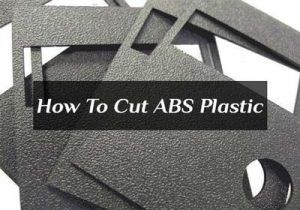
Just like a slab of wood, plastic can be cut using similar techniques. ABS is a plastic variant that exhibits a wide array of useful properties. It is a material that is found in numerous day-to-day products.
ABS plastic is generally used in household or personal 3D printing. People usually use FFF or FDM 3D printers for this purpose. ABS is widely popular, particularly because it can be used with desktop or ABS 3D printers. It’s also cheaper than other alternatives.
If you are working on a 3D Printing project that requires ABS plastic, then you may want cuts of various sizes and shapes.
Cutting ABS plastic requires power tools, however, if the piece you are working on is thin enough, it can be cut simply by scorching it repeatedly using a utility knife.
Cutting ABS plastic requires precision and focus. In most cases, you either need to take control of the power tool while the plastic piece itself is stationary or feed the piece to the machine by maneuvering it.
In this article, we will discuss how to cut ABS plastic for 3D printing purposes. Getting the perfect cuts may take some practice at first but once you have mastered the techniques, you will find yourself turning large plastic sheets into sizable pieces in no time!
What Is ABS Plastic And Why It Is Used In 3D Printing?
ABS plastic is a kind of thermoplastic polymer. It is commonly used in the injection molding process and 3D printing. It holds certain properties that make it suitable for 3D printing uses.
- Desktop 3D Printer Friendly– What makes ABS so remarkable, is that it can be melted, cooled, and then reheated again without showing any signs of degradation.
- Low Melting Point– The material tends to liquefy instead of burning when exposed to high heat. This allows them to be easily injected in moldings.
- Structural Integrity– The material is known for its high rigidity, and excellent impact resistance. It also has structural strength and incredible insulating properties.
- 3D Printing Applications– This variant of plastic is used in 3D print manufacturing. ABS has several applications and are found in most common objects made by a 3D printer.
For example, it is used to manufacture toys and sports equipment. You’ll find toys like Kre-O bricks and Legos are made by this filament.
Due to its high impact strength and great thermal properties, it is best suited for automotive, home appliances, and electronic parts. ABS plastic is used in the dashboard of your car, pipe fittings, and more.
How To Cut ABS Plastic: 4 Different Method
Now that you know what an ABS plastic is, let’s find out the best ways of cutting them. There are multiple ways to cut plastic.
As easy as it may seem, there is always a chance of damaging them in the process. By using the proper techniques, you can achieve a perfect cut of plastic every time.
Here are some of the techniques you can put into practice when cutting ABS plastic:
1. Using A Plastic Cutter
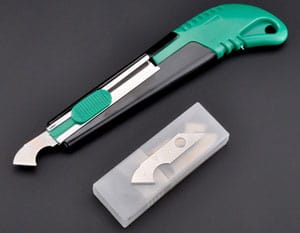
A plastic cutter or a similar utility knife can be used to cut thin sheets of ABS plastic. This method works best if the sheets you are working on is approximately ⅛ inch thick.
- Prepare the work surface and lay the plastic on it.
- Secure it with a clamp to prevent the material from moving.
- Then mark the cutting line with a highlighter. This will act as a guideline and will help you achieve the shape you are looking for. If you are working on a plastic sheet, make the marks on both sides.
- Make several scores along the guideline. The groves should go halfway through the ABS plastic sheet.
- After that, flip the ABS plastic over and score the material along the highlighted lines.
- Then reposition the sheet and line up the grooved section to the edge of your workbench. Remember to secure it using a clamp.
- Finally, break the portion that is hanging off from the workbench by snapping it.
2. Using A Circular Saw
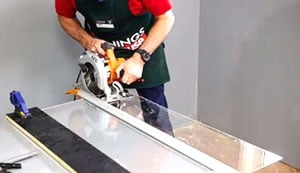
To make linear cuts on thick ABS plastic sheets, you need a table or a circular saw. If you have a sheet that has a thickness of more than ⅛ inches, then this method will work best for you.
- The first step is to mark the cutting line using a highlighter. If you are using a sheet, make sure you mark the backside as well.
- Then secure the plastic using a clamp. Fix the material to the edge of your workbench. This will it firmly in place and stop any movements.
- After that, start sawing the plastic very carefully. Use the guideline you have previously drawn to navigate your saw.
- When the plastic is cut, allow it to cool for a while. The friction from the blades heats the material so simply let it sit for a couple of minutes before taking any additional steps.
3. Using A Jigsaw
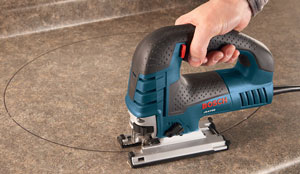
A Jigsaw is different from a table or circular saw. While a circular saw can be the best tool for making straight cuts, a jigsaw can be used for complex curved cuts. Jigsaw has better mobility, which allows you to create curved cuts into the ABS plastic. This tool is perfect for thick ABS plastic.
- Using a marker or a highlighter, draw a cut line on the plastic sheet or pipe. You can also drill holes along the guideline if you want to.
- Then hold the material firmly using a clamp.
- Switch on the jigsaw and cut the plastic along the marked line. If you are cutting a curve, slowly turn the jigsaw and keep as steady as possible.
4. Using A Band Saw
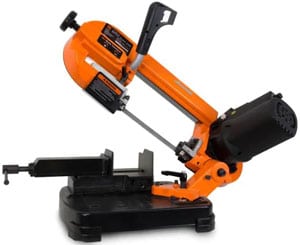
If you want to achieve circular and linear plastic cuts, a band saw will get the job done. Compared to other saw variants, a band saw comes with a long ribbon-likee blade. The blade comes up through the table’s surface. It allows for detailed and precise cuts. If you have a portable band saw, then you can easily cut thick ABS plastic sheets.
- Mark the cut lines using a highlighter.
- After that set the height of the blade guard guide. Get it as close as possible to the sheet.
- Then turn on the machine and slowly feed the ABS plastic into the saw blade.
- To create curves, steer the piece of plastic from behind as you are pushing it through.
Tips And Caution When Cutting ABS plastic
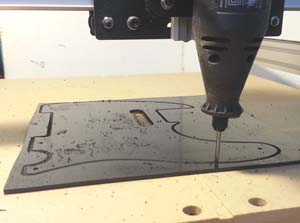
- Switch On The Saw Before Cutting The Material.
Try not to switch on the saw while it is in contact with the plastic. This may chip off some of the plastic segments, damaging the material. Always start cutting when the saw runs at its best.
- Wear Safety Gear At All Times
Keep your eyes protected by wearing safety goggles. When cutting ABS plastic, there is always a chance of stray plastic pieces flying towards you. Also, use protective gloves to prevent any cuts from sharp plastic edges.
- Don’t Tighten The Clamp Too Much
You need to clamp the ABS plastic on your workbench to stop it from moving. Over tightening the material can damage the material. The clamp should only be tightened if it is not completely secured to the workbench.
- Use A New Blade When Cutting.
An old saw blade may make the process difficult. It might also damage the material and give you a rough cut surface. A new blade will give you a smooth cutting experience.
- Using A Masking Tape As A Guideline
You can always use masking tape instead of a highlighter to mark your cut lines. The tape can simply be peeled off after you have cut the plastic. This way you don’t have to wipe the marked lines.
- Take Your Time
The friction generated from the blade when cutting the plastic can cause the material to heat up. This can cause the plastic to melt. Take your time when cutting through the material. Give the material some time to cool off if it starts to get hot.
- Cut The Plastic Outside The Marked Line
Always try to leave some additional room in between the marked lines and the cut you are about to make. The extra room will ensure that you don’t cut too much into the shape. Any extra plastic sticking out can always be filed down after you have finished cutting the piece.
- Smooth The Edges After Cutting
Your piece will probably be left with rough edges after being cut. Using a metal file, you can smooth out any bumpy or rigid edges. Keep using the file till the point the edges are smooth. Make sure to use long and steady motions to prevent heating and in turn melting the plastic.
- Keep Your Work Bench Clean
Clean off any debris or particles before you lay the material on your workbench. This maintains the integrity of the material and prevents any debris from scratching the surface of the plastic. Wipe the dirt using a cloth.
Conclusion
You may find some similarities between cutting wood and plastic. However, cutting plastic is an entirely different story.
One striking difference between these two materials is that the way plastics behave. ABS plastic is tricky to handle as it may melt during the cutting process.
Also, an error in cutting can cause irreversible damage to the plastic sheet. To avoid this, you must take proper precautions while cutting it.
The technique you use will vary depending on the thickness of the ABS plastic and the style of cut you are looking for.
We hope the methods and tips we mentioned in this article will aid you to cut ABS plastic just the way you want it.
More 3D Related Topic: